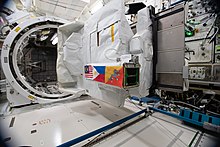UiTMSAT-1
 UiTMSAT-1 in Space | |
| Mission type | Technology demonstration |
|---|---|
| Operator | Universiti Teknologi MARA |
| COSPAR ID | 1998-067PD |
| SATCAT no. | 43589 |
| Website | birds2 |
| Mission duration | 6-9 months (planned) |
| Spacecraft properties | |
| Spacecraft type | 1U CubeSat |
| Manufacturer | Universiti Teknologi MARA |
| Launch mass | 1.11 kg |
| Dimensions | 10 × 10 × 10 cm |
| Start of mission | |
| Launch date | 29 June 2018, 09:42 UTC |
| Rocket | Falcon 9 Full Thrust |
| Launch site | Cape Canaveral, SLC-40 |
| Contractor | SpaceX |
| Deployed from | International Space Station |
| Deployment date | 10 August 2018 |
| End of mission | |
| Decay date | 20 November 2020 |
| Orbital parameters | |
| Reference system | Geocentric orbit |
| Regime | Low Earth orbit |
| Perigee altitude | 398.6 km |
| Apogee altitude | 407.2 km |
| Inclination | 51.6° |
| Period | 92.5 minutes |
UiTMSAT-1 was a Malaysian nanosatellite, built primarily by Universiti Teknologi MARA (UiTM) as part of the multi-nation Birds-2 project. The 1U CubeSat was launched into space on 29 June 2018 and deployed from the International Space Station (ISS) on 10 August 2018.
Background
[edit]Malaysia has had several satellites in orbit, beginning with the MEASAT constellation, first operational in 1996. Their first microsatellite, TiungSAT-1, was launched in 2000.[1]
Development
[edit]Planning for the mission began in December 2016 at the Kyushu Institute of Technology (KIT). UiTM postgraduate students Syazana Basyirah Mohammad Zaki and Muhammad Hasif Azami developed the satellite over a 19-month period and collaborated with eight other students from the Philippines, Bhutan, and Japan. This collaboration also inspired the creation of a new Communication Satellite Centre at Universiti Teknologi MARA (UiTM).[2]
Objectives
[edit]- Demonstrate an Automatic Packet Reporting System digipeater to communicate with amateur radio stations.
- Detect a specific type of solar radiation called "single event latch-up".
- Measure magnetic fields through the use of an Anisotropic Magneto Resistance Magnetometer.
- Act as an Earth Imaging Camera.[2]
Launch and mission
[edit]

UiTMSAT-1 was launched to space on 29 June 2018 by the Falcon 9 Full Thrust rocket at Cape Canaveral in Florida, United States as part of the SpaceX CRS-15 Commercial Resupply Service mission.[2] Maya-1 and BHUTAN-1, which were also developed under the Birds-2 project, were among the payload of the rocket.[3] All three nanosatellites were deployed from the International Space Station (ISS) and achieved orbit on 10 August 2018.[4][5]
References
[edit]- ^ "Satellite Industry Developments" (PDF). Malaysian Communications and Multimedia Commission. 2008. pp. 28–29. ISSN 1985-0522.
- ^ a b c Mustafa, Zulita. "UiTMSAT-1 puts Malaysia at the final frontier". New Straits Times. Retrieved 19 December 2018.
- ^ Panela, Shaira (29 June 2018). "Philippines launches first CubeSat into space". Rappler. Retrieved 4 July 2018.
- ^ "CubeSat Maya-1 successfully deployed to space". Philippine Council for Industry, Energy and Emerging Technology Research and Development. 31 August 2018. Retrieved 19 December 2018.
- ^ Bernama (11 August 2018). "UiTM creates history with launch of satellite into orbit". New Straits Times.
